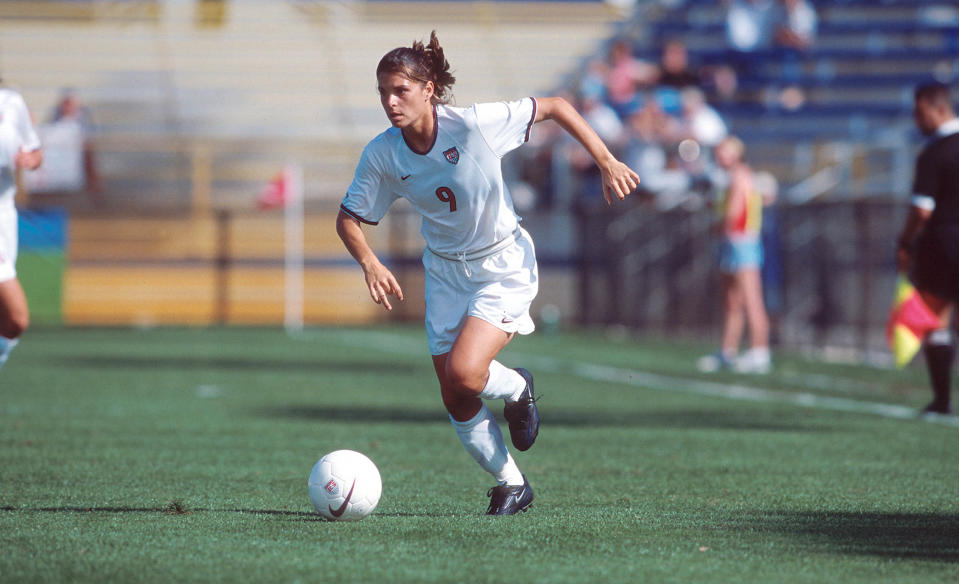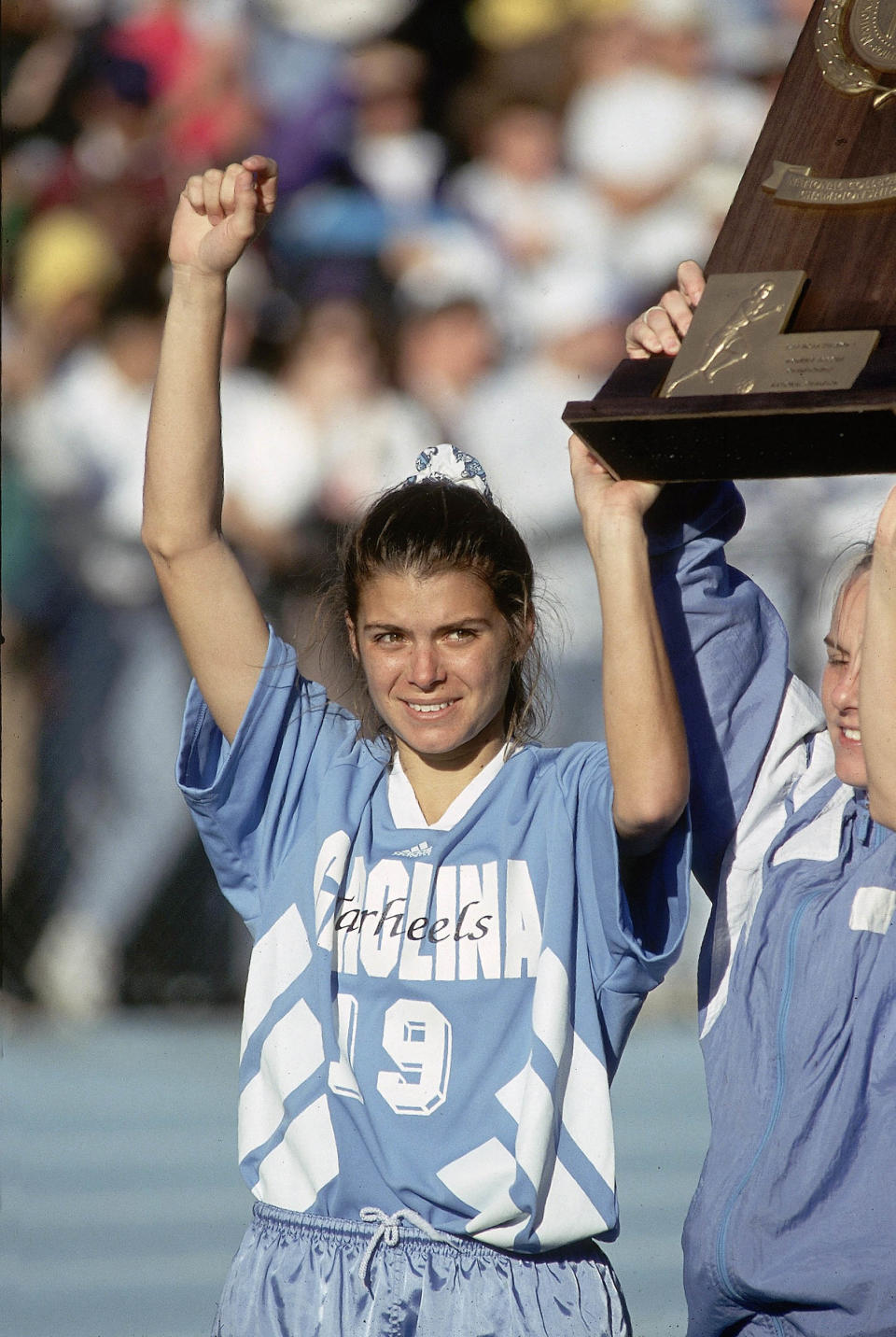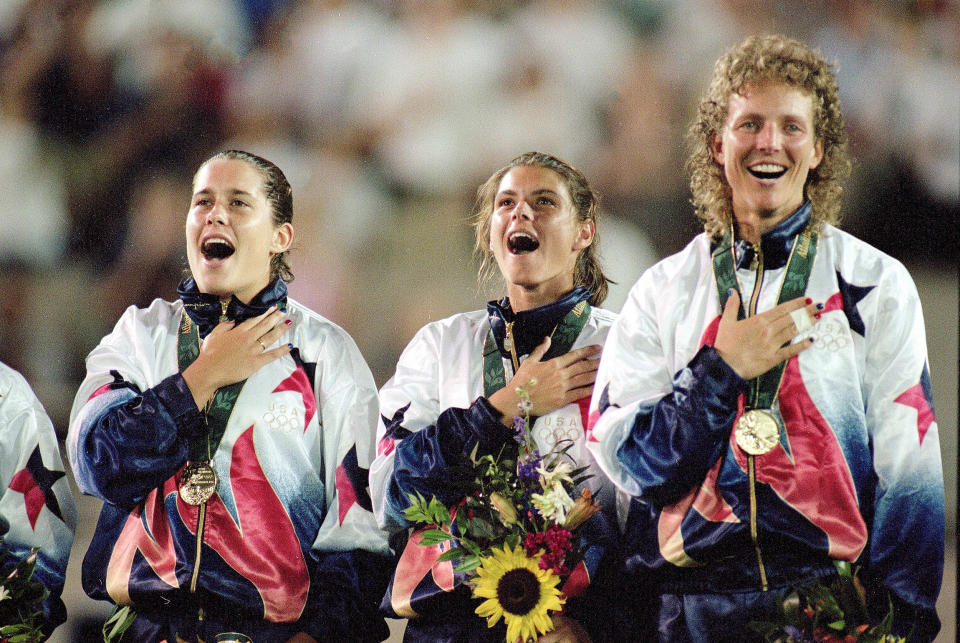Mia Hamm recalls 1st sign her brother had blood disorder that eventually took his life
- Oops!Something went wrong.Please try again later.
Mia Hamm had countless reasons for her family to come together over the course of her historic soccer career, but the two-time Olympic gold medalist remembers one gathering born from tragic circumstances.
The two-time FIFA Women’s World Cup Champion lost her brother Garrett in 1997 after complications from a bone marrow transplant. Years earlier, Garrett was diagnosed with a rare and unpreventable disease called aplastic anemia, when a person’s bone marrow is unable to create enough new blood cells for the body to function normally, according to the National Heart, Lung, and Blood Institute.
In 1999, the soccer superstar created the Mia Hamm Foundation to raise awareness and funds for bone marrow and cord blood transplants. Today, nearly a quarter century later, Hamm continues to be an advocate for the bone marrow transplant community and is partnering with biopharmaceutical company Incyte to raise awareness of complications following bone marrow transplants.
In a recent interview with TODAY.com, Hamm reflects on Garrett’s impact on her life and career and how her U.S. women’s national soccer teammates stepped up to support her during a time when she needed it the most.
Hamm, 51, grew up with five siblings — three girls and two boys. Her two brothers joined the family later through adoption. Hamm was about 5 years old when 8-year-old Garrett entered her life.
“We always tease my parents. We’re like, ‘OK, you had … four girls. … You can’t have another girl,’” Hamm recalls. “But if you talk to them, they said, ‘No, we always wanted to adopt,’ and just felt that they were in a good place in their lives and were focused on adopting an older boy, which was my brother Garrett.”
Her parents also adopted a younger boy, Martin, when he was about 2 and a half months old, Hamm says.
“Our lives changed,” she adds. “Garrett was a bit longer of a process just because he was older. He came and stayed with us for a week.”
After some counseling and feeling out if Garrett wanted to join the family, the Hamms went through the adoption process.
“I remember I was like, ‘Oh, my gosh! He got a bike, so I was able to get a new bike. And he got a new skateboard, so I was able to get a new skateboard.’ I was like, ‘This is great!’”

Growing up, the two bonded over playing sports together, and Hamm says Garrett never discouraged her from tagging along with him and his friends, “even though it probably wasn’t super cool” to bring his little sister. “I just knew he loved me and cared about me and was proud of me because he let me hang out with him.”
In high school, Garrett noticed something wrong with his body, leading to a diagnosis that forever changed his life.
“He was the quarterback of the football team and had played in a scrimmage. … Both of us had to go get our physical,” Hamm recalls. “My dad was in the Air Force, so we went to the Air Force base to get our physical, and Garrett had all this unusual bruising from the game, like discolored. It was more orange rather than the kind of purplish bruising.
“The discoloration concerned the doctor, and he had a lot of it. So they ... did some bloodwork and then sent him to a specialist, and that’s when it came back that he had aplastic anemia.”
Hamm says the “hardest part” of the diagnosis for Garrett was doctors telling him he could no longer play contact sports because sports were “such a big part” of his life.

Not long after, Hamm fast-tracked her last years of high school to focus on soccer. Her family moved to Italy while she stayed in the U.S. to begin college at women’s soccer powerhouse University of North Carolina at Chapel Hill. She left the school in her second year to play with the national team full time and later returned to UNC in 1992. After a historic run at UNC with four national championships under her belt, Hamm’s star only continued to rise with the U.S. women’s national soccer team. In 1996, the team played in the first Olympic Games to include women’s soccer and won the gold.
One of the most special parts of Hamm's big moment was Garrett seeing the team win in person.
“We knew he was sick, and he was able to come to the Olympics towards the end, which we weren’t sure he was going to be able to, and he did so that was very special for all of us,” Hamm says.
“I think our parents hid how sick he really was just so we would keep living our lives,” she adds.

Later that summer, Garrett learned he needed a bone marrow transplant. “They pretty much told him that because his body wasn’t producing any healthy blood cells,” Hamm explains.
To help with the cost, Hamm went to an event in Milwaukee and brought a pickle jar covered with a picture of Garrett and information about his transplant and how to become a bone marrow donor.
The idea for a benefit game was born, and almost all of Hamm’s U.S. women's national teammates played to support her. They took on college seniors from the Chicago-Milwaukee area and raised around $80,000, which was split between the children’s hospital in Milwaukee and her brother. The event was the start of the Mia Hamm Foundation.
“Garrett wasn’t around to see (the foundation) come to life, but he’s the inspiration every step of the way,” she says.
Garrett’s journey to finding a donor was not easy. “Because he was adopted, none of us were a good match for him,” Hamm adds.
After trying and failing to find a donor through the national bone marrow registry, Hamm says they were able to locate and connect with Garrett’s biological father, who ended up being his match.
Garrett kept in touch with his biological father afterward, and Hamm believes “it brought a lot of closure” to his life, which she says made her family happy for him.
While the transplant was a success, Garrett later developed a fungal infection, and because his immune system was suppressed after the transplant, the infection “took over rather quickly,” Hamm recalls, adding that the speed of his decline “was the hard part.”
A silver lining, though, was that “it brought us all together,” she says. “He had his transplant in South Carolina, (and) a majority of my family was living in Texas. So we all came and were with him until the very end. … We always talk about one of his last gifts to all of us was bringing us together.”
For families going through a similar experience, Hamm emphasizes the importance of proper education, like recognizing symptoms of any possible complications, both before and after a bone marrow transplant, and “not to think that any little bit of change is minor.”
For example, graft-versus-host disease — when donated cells attack the recipient's cells — is a possible complication of bone marrow transplants, and its symptoms can be nonspecific, like nausea, rash and vision changes. Resources for patients and families like GVHD Now were not available when Garrett was sick, Hamm says.
“I think more information and creating a really strong ... medical team is so important,” she says.
Now, Hamm has three children with husband and former MLB star Nomar Garciaparra: twin girls Ava and Grace, 16, and son Garrett, 11.
Her brother Garrett also had a child before he died in his late 20s, a boy named Dillon.
“Dillon is very much like Garrett, and he has a sense of humor,” Hamm says. “I tell my kids, ‘When you see your cousin … that’s a lot like your Uncle Garrett.’ The dry, slow sense of humor. … I just tell them about how much he inspired me and supported me through sports and how that changed my life.”
“When we go to my parents’ (house), there are pictures everywhere, and our son knows who he’s named after.”
Hamm's and her husband's — and, of course, Garrett's — interest in sports has also been passed on to her kids. “Everyone has played something,” she says.
“The girls are in high school so they play some high school sports,” she says. “Our son loves — he wants to be a YouTuber, and he loves video games. We tell him his comedic timing is really good. So I wouldn’t be surprised if he’s a comedian because he’s just funny. He makes me laugh every single day.”
This article was originally published on TODAY.com

